This article describes the structure and properties of the developed hybrid composite Hastelloy X (NiCrFeMo)-AlMoNbTaTiZr-cBNSiCNiAlCo. The composite was obtained by the high velocity oxygen fuel spraying (HVOF) method in a protective atmosphere with a subsequent high-temperature thermomechanical treatment. In order to obtain new information about the structure, we studied the metallophysical properties of the composite using electron microscopy and X-ray diffraction analysis, as well as the mechanical properties and phase composition. We studied the influence of high-energy mechanical processing of high-entropic and ceramic materials on the structural-phase state and composite quality. We determined the optimal technological parameters of HVOF in a protective atmosphere, followed by a high-temperature thermomechanical treatment. Additionally, we optimized these parameters to form a hybrid composite providing the highest adhesion and low porosity. Moreover, we investigated the microhardness of the composite layers. On the basis of complex metallophysical studies, we examined the composite formation. In order to determine the endurance limit in comparison to various other composite materials, we carried out cyclic endurance tests of the developed materials.
Citation: Peter Rusinov, Zhesfina Blednova, Anastasia Rusinova, George Kurapov, Maxim Semadeni. Study of the structure and mechanical properties of composites used in the oil and gas industry[J]. AIMS Materials Science, 2023, 10(4): 589-603. doi: 10.3934/matersci.2023033
| [1] | Azevedo Joaquim, Mendonça Fábio . Small scale wind energy harvesting with maximum power tracking. AIMS Energy, 2015, 2(3): 297-315. doi: 10.3934/energy.2015.3.297 |
| [2] | Lin Dong, Michael Grissom, Frank T. Fisher . Resonant frequency of mass-loaded membranes for vibration energy harvesting applications. AIMS Energy, 2015, 3(3): 344-359. doi: 10.3934/energy.2015.3.344 |
| [3] | Guy M. Toche Tchio, Joseph Kenfack, Joseph Voufo, Yves Abessolo Mindzie, Blaise Fouedjou Njoya, Sanoussi S. Ouro-Djobo . Diagnosing faults in a photovoltaic system using the Extra Trees ensemble algorithm. AIMS Energy, 2024, 12(4): 727-750. doi: 10.3934/energy.2024034 |
| [4] | Amine Ben Alaya, Charfeddine Mrad, Férid Kourda . Piezoelectric energy harvesting under free and forced vibrations for different operating conditions. AIMS Energy, 2024, 12(6): 1334-1365. doi: 10.3934/energy.2024060 |
| [5] | K. M. S. Y. Konara, M. L. Kolhe, Arvind Sharma . Power dispatching techniques as a finite state machine for a standalone photovoltaic system with a hybrid energy storage. AIMS Energy, 2020, 8(2): 214-230. doi: 10.3934/energy.2020.2.214 |
| [6] | Joaquim Azevedo, Jorge Lopes . Energy harvesting from hydroelectric systems for remote sensors. AIMS Energy, 2016, 4(6): 876-893. doi: 10.3934/energy.2016.6.876 |
| [7] | Ammar E. Ali, Nicholas C. Libardi, Sohel Anwar, Afshin Izadian . Design of a compressed air energy storage system for hydrostatic wind turbines. AIMS Energy, 2018, 6(2): 229-244. doi: 10.3934/energy.2018.2.229 |
| [8] | Nagaraj C, K Manjunatha Sharma . Fuzzy PI controller for bidirectional power flow applications with harmonic current mitigation under unbalanced scenario. AIMS Energy, 2018, 6(5): 695-709. doi: 10.3934/energy.2018.5.695 |
| [9] | Mohamed G Moh Almihat . An overview of AC and DC microgrid energy management systems. AIMS Energy, 2023, 11(6): 1031-1069. doi: 10.3934/energy.2023049 |
| [10] | D. Marene Larruskain, Inmaculada Zamora, Oihane Abarrategui, Garikoitz Buigues, Víctor Valverde, Araitz Iturregi . Adapting AC Lines to DC Grids for Large-Scale Renewable Power Transmission. AIMS Energy, 2014, 2(4): 385-398. doi: 10.3934/energy.2014.4.385 |
This article describes the structure and properties of the developed hybrid composite Hastelloy X (NiCrFeMo)-AlMoNbTaTiZr-cBNSiCNiAlCo. The composite was obtained by the high velocity oxygen fuel spraying (HVOF) method in a protective atmosphere with a subsequent high-temperature thermomechanical treatment. In order to obtain new information about the structure, we studied the metallophysical properties of the composite using electron microscopy and X-ray diffraction analysis, as well as the mechanical properties and phase composition. We studied the influence of high-energy mechanical processing of high-entropic and ceramic materials on the structural-phase state and composite quality. We determined the optimal technological parameters of HVOF in a protective atmosphere, followed by a high-temperature thermomechanical treatment. Additionally, we optimized these parameters to form a hybrid composite providing the highest adhesion and low porosity. Moreover, we investigated the microhardness of the composite layers. On the basis of complex metallophysical studies, we examined the composite formation. In order to determine the endurance limit in comparison to various other composite materials, we carried out cyclic endurance tests of the developed materials.
Recent advances in lowering power demands of wireless remote sensors has afforded the ability to power these sensors with micro-watt power levels. In situations where periodic change of the batteries is not desired, powering the sensors through wireless power sources provides an effective alternative. As a result, wireless RF energy harvesting from ambient sources or from dedicated transmitters has gained research interest for use in these sensor systems. The major challenge in passive wireless energy harvesting is the efficient transformation of the input EM power levels that are less than −10dBm to the voltage and current demands of the direct current (DC) load. A passive RF to DC power harvester must be optimized at each stage of the circuit design for true implementation of this energy harvesting approach. An RF power harvester consists of a receiving antenna, an impedance matching/transformation network, DC power conditioning and or management and the wireless sensor to be powered. Figure 1 shows a schematic of a passive wireless RF energy harvester. The rectifier may be a single diode or diode-connected transistor, or a cascade of rectifiers. In-between the antenna and the rectifier is an impedance matching or transformation network. The matching network consists of passive components providing inductive or capacitive reactance. The load represents the DC storage or transformation elements and the sensor to be powered.
 Figure 1. Block diagram of a passive wireless RF energy harvester. ηant, ηΓ and ηrect are the efficiencies of the receiving antenna, impedance transformation network and the rectifier respectively.
Figure 1. Block diagram of a passive wireless RF energy harvester. ηant, ηΓ and ηrect are the efficiencies of the receiving antenna, impedance transformation network and the rectifier respectively.
The design of fully passive RF harvesters lies in the accurate modeling of the complete rectifier circuit so that its output performance can be predicted. Harrison et al. [1] used Ritz-Galerkin analysis to present the DC output characteristics of a single diode rectifier with some restrictions. The model neglects the diode junction capacitance and therefore the output DC voltage dependence on the operating frequency. A closed-form equation was presented in [2] that approximates a diode rectifier efficiency and input impedance. In [3,4], models that predict the conversion efficiency of an N-stage full-wave rectifier was presented. However, the DC load current must be determined or maintained to satisfy the constraints in the model. HB simulations using Agilent ADS software can be used to determine the output DC voltage of a rectifier circuit, however it is computationally intensive and do not easily provide the global view of the circuit response [1].
In this paper, a linearized model is presented to determine the output behavior of rectifying circuits. The model assumes steady state conditions and may be applied at various input power levels and connected DC load resistance without neglecting the impedance matching effects and the dynamic influence of the diode impedance on the rectifying process.
With the appropriate design of a rectifier circuit, ambient electromagnetic power harvesters may be realized. In our previous work [5,6], wireless RF power transfer were presented in the ISM bands using intentionally generated sources. In [7,8] and [9], ambient RF power harvesters from television (TV) transmitting base stations at the frequency band of (450 to 770)MHz were presented. In [7] for example, the TV base station transmitting about 960kW was able to power sensors requiring up to 60µW at a distances of 4.1km. In [8] and [9], it was shown that a single TV base station can provide multiple TV channels for harvesting. However published work using ambient TV base station signals relies on antenna sizes in the range of 1.5A4 size or larger for harvesting. These antenna sizes corresponds to at least half of the operating wavelength at (450 to 770)MHz.A rectenna that is larger than A4 size hinder practical integration of the system into modern wireless sensors. In [10], a survey was made to prove the possibility of harvesting RF energy from ambient sources such as GSM. GSM base station transmitters may be the most available in urban environments due to the immense availability of cellular network providers.
In this paper, an ISM band 868MHz and ambient GSM wireless RF harvester is presented. Planar antenna sizes as small as 6cm × 8cm (~λ/4 at 900MHz) may be used with the rectifier for ubiquitous RF harvesting. The rectifier is designed to operate with dual-band frequency. Using this approach, ubiquitous RF power sources in the range of −27dBm to −50dBmand from different frequencies can be utilized for continuous operation of micro-watt sensors.
This paper is structured as follows. Section 2 presents the rectifying circuits and the linearized analytical model. Section 3 presents the verification of the model and its comparison to ADS software HB simulations and measured results. Section 4 presents the design consideration and trade-off when realizing RF power harvesters. The design considerations are based on the presented model. Section 5 presents harvesting RF power from intentionally generated sources at indoor conditions and from ubiquitous sources using a GSM base station at outdoor conditions. Conclusions are given in section 6.
Efficiency η is defined as in(1), where PL is the output DC power and PA is the input RF power. The voltage sensitivity γis given by (2), where VL is the output DC voltage.

The current state of the art of low power sensors would require a DC voltage supply of about 1V and DC current of 10µA. Therefore, it is necessary to specify the output voltage and current separately rather than the product, the DC output power, when considering RF energy harvesters for remote sensors [4,11]. The delivered input RF power PA from the receiving antenna must be transformed to that minimum voltage required to energize the sensor. Although the efficiency is widely presented in literature, its practical use in ambient RF energy harvesting can be limited. This is because an RF harvester can deliver an output DC power more than what is required by a remote sensor but may be unable to energize the sensor due to its specific voltage and input current demands. Therefore, voltage sensitivity of a passive RF harvester may be more important than the output efficiency when powering DC loads from micro-watt RF power levels, as such more emphasis is placed on the γ rather than η in this paper.
As shown in Figure 1, an impedance transformation network is a sub-system of a wireless RF harvester. The impedance transformation network filters higher order impedances of the diode at the operating frequency. For this reason, only the diodes fundamental impedance at the frequency of operation may be required for its accurate modeling in RF energy harvesting applications. A packaged Schottky diode may be modeled as a nonlinear junction resistance Rjshunted by a non-linear junction capacitance Cj. Vj is the voltage loss at the rectifying junction. RS, LS and CP are the bulk resistance, packaging inductance and capacitance respectively [12]. A bare diode may also be modeled as a voltage controlled junction current source in parallel with a controlled capacitance (seeFigure 2) and a parasitic bulk resistance [13]. IDC is the voltage controlled current source from the rectifying junction. Without neglecting the bulk resistance and the package parasitics, the controlled current source is treated as a DC source in parallel with a conductance G and a susceptanceB. RD and XD are the parallel resistance and reactance of the diode respectively. IDC, RD and XD as in the linearized model are variables which depend on the diode parameters, input RF power PA, the connected DC load and the reflection coefficient at the input of the rectifier.
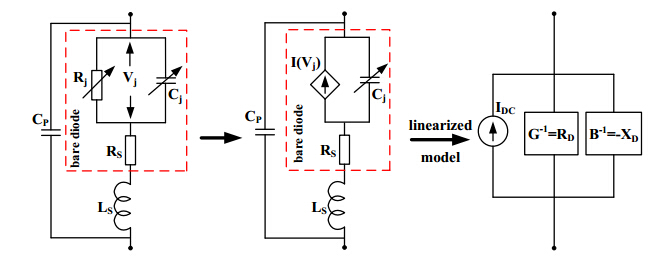 Figure 2. Schottky diode equivalent circuit models.
Figure 2. Schottky diode equivalent circuit models.
From Figure 2 (Left), the admittance of a Schottky diode may be written as in (3), where Ydiode is the diode admittance.

Equation (3) can be expanded into the conductanceG and susceptanceB. The expression for Cj[13] is given by (4). Where Q is the charge stored at the rectifying junction.

Rj can be found from Richardson’s equation [14], which describes the current voltage relationship at the rectifying junction of a Schottky diode. The current voltage relationship at the rectifying junction is given by (5).

ISis the diode reverse saturation current, . α is the thermal voltage. η0 is the diode ideality factor. qis the charge of an electron. T is the temperature and K is the Boltzmann constant. Since I is an infinite series with higher order values, there are higher order values of the diode junction resistance Rj.

Ivaries with changes in the input RF power level PA, the losses in the impedance transformation network, rectifier impedance or connected DC load. It is easily deduced from (6) that the magnitude of I also affects the junction resistance Rjand consequently the overall impedance of the diode. Due to this, the input impedance of a diode must always be measured at a specified RF power level and DC load conditions.
The effect of a Schottky diode equivalent circuit parameters on the parallel resistance is presented. This allow for direct comparison of each diode parasitic parameter on the RD. The diode parasitic parameters which were used in calculating the diode impedance are shown in Table 1. VBV is the reverse breakdown voltage of the Schottky diode.
| IS(nA) | I(nA) | Cj(pF) | RS(Ω) | LS(nH) | CP(pF) | VBV(V) |
| 50 | 2 | 0.18 | 6 | 2 | 0.08 | 7 |
Figure 3(Top-left) shows the effect of the saturation current IS on the diode rectifying junction voltage losses Vj, for various values of I. AtI in the range of 5µA, the Vj across both the IS=0.5µA and the IS=50nA approaches zero. When the I passing through the diode rectifying junction is greater than about 0.05mA, the efficiency of rectification is skewed to the one with IS=0.5µA, since the peak Vj of the diode with IS=50nA is much higher at this condition. The results show that the smaller the I that goes through a Schottky diode rectifying junction, the smaller the Vj across it. Therefore the ηrect of a Schottky diode increases with high input voltage instead of high input current. Hence maximum voltage transformation at the input of the diode rectifier is always necessary for its efficient operation. The voltage transformation of the input RF power will reduce the amount of current passing through the diode rectifying junction.
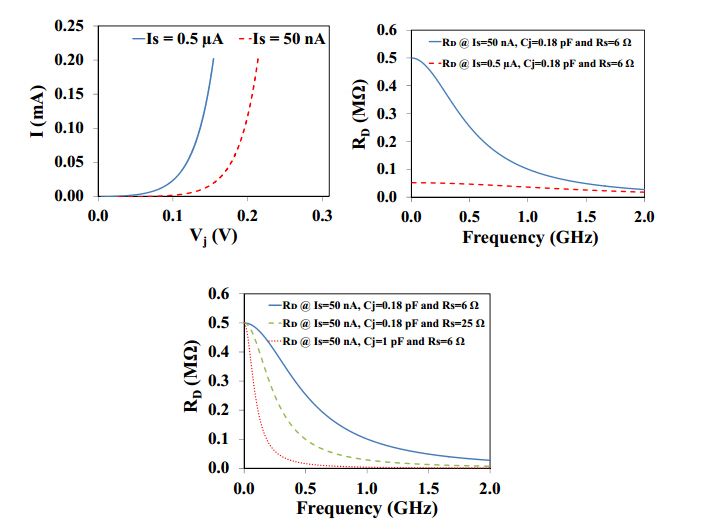 Figure 3. The effect of the changes in the equivalent circuit parameters of a Schottky diode on the parallel resistive impedance, RD. (Top-left) Effect of the saturation current IS on the Vj at 25°C for different currents I passing through the rectifying junction. (Top-right) Schottky diode parallel resistive impedance RD as a function of different IS. (Bottom) Schottky diode parallel resistive impedance RD as a function of different bulk resistances RS, and junction capacitances Cj.
Figure 3. The effect of the changes in the equivalent circuit parameters of a Schottky diode on the parallel resistive impedance, RD. (Top-left) Effect of the saturation current IS on the Vj at 25°C for different currents I passing through the rectifying junction. (Top-right) Schottky diode parallel resistive impedance RD as a function of different IS. (Bottom) Schottky diode parallel resistive impedance RD as a function of different bulk resistances RS, and junction capacitances Cj.
Figure 3(Top-right) and Figure 3(Bottom) show the calculated effect of IS, RS and Cj on the parallel resistive impedance RDof a diode. From Figure 3(Top-right), as the ISis increased from 50nA to 0.5µA, theRD reduces. From Figure 3(Bottom), as the junction capacitance Cj is increased from 0.18pF to 1pF, the RD of the diode reduces. By increasing RS from 6Ω to 25Ω, the RD reduces as well. The results shows that a Schottky diode with a low IS, RS and Cj will have high RD. The results also show that at ultra-high frequency (UHF), the RD of a diode is in the range of a few kilo-ohms.
Figure 4 shows a fabricated RF harvester realized at 930MHz on anFR4 printed circuit board using off-the-shelf discrete components. VS is the input RF voltage. RAis the RF source resistance. RL is the DC load resistor. The impedance transformation network is realized with an inductive coil resonator and a chip capacitor. The unloaded quality factor Qu of an impedance transformation element is used as the performance parameter for selection a component. Quis given by Equation (7), where XCoil and RCoilare the net series reactive and resistive impedance of the inductive transformation element respectively. As can be seen in Figure 3, the RD of a Schottky diode at about 900MHz is in the range of a few kilo-ohms. The voltage transformation that can be achieved at the input of a Schottky diode is directly proportional to the @\sqrt {{{\rm{R}}_{\rm{d}}}} @ at resonance [5] as in (8). Where VD is the voltage at the input of the diode rectifier. When the RF voltage amplification at the input of the diode is limited due to a lower value of RD, the rectifier efficiency is skewed toward diodes with saturation current IS in the micro-amp range (see Figure 3(Top-left)), since more current I passes through the rectifying junction. Hence the AvagoTechologiesHSMS-285 series of diodes with IS=3µA were used at 930MHz to realize the RF harvester.

 Figure 4. PCB of the realized RF harvester at 930MHz using a HSMS-285C diode voltage doubler. The HSMS-285C has the following spice parameters IS = 3µA, Cj = 0.18pF and RS= 25. Coil = 38.5nH at 900MHz with a Qu of 69. The chip capacitors have Qu of about 1000 at 900MHz.
Figure 4. PCB of the realized RF harvester at 930MHz using a HSMS-285C diode voltage doubler. The HSMS-285C has the following spice parameters IS = 3µA, Cj = 0.18pF and RS= 25. Coil = 38.5nH at 900MHz with a Qu of 69. The chip capacitors have Qu of about 1000 at 900MHz.
The linearized impedance diagram of the RF rectifier shown in Figure 4 is presented in Figure 5. IDC is the same for each diode since two identical diodes are assumed. IDCmay be found from (10). Pin is the power absorbed at Zinplane as in (9). Where Γ is the reflection coefficient at the Zin plane (see Figure 4). N is the number of doubler stages.
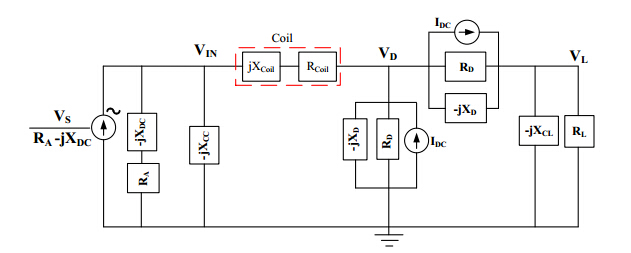 Figure 5. Linearized model of the RF power harvester at 930MHz.XDC is the reactance of DC block capacitor. XCC is the reactance of 2.4pF capacitor. RCoiland XCoil are the series resistive and reactive impedance of the coil respectively. XCL is the reactance of the 100pF capacitor. RL is the load resistor.
Figure 5. Linearized model of the RF power harvester at 930MHz.XDC is the reactance of DC block capacitor. XCC is the reactance of 2.4pF capacitor. RCoiland XCoil are the series resistive and reactive impedance of the coil respectively. XCL is the reactance of the 100pF capacitor. RL is the load resistor.

After the linearized model is setup as in Figure 5, the steady state output voltage VL is found using nodal analysis. From Figure 5, (11), (12) and (13) may be used to determine the voltages at node VIN, VD and VL.
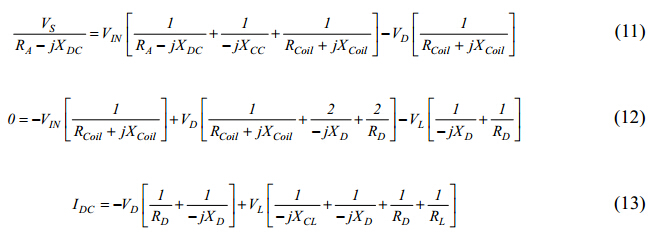
From (11) to (13), the minima of VL occurs when IDC in the doubler diodes limits to zero. IDC≈0 implies the diodes are not rectifying at the input RF power level. Hence the output voltage VL approaches (14). The alternating current (AC) output voltage when IDC=0 is given by VL_AC.
| VL→ VL_AC | (14) |
The maxima of the output voltage VLapproaches (15). For N number of doublers, the upper limit of the VL is increased by a factor N.
| VL→2NVD | (15) |
The RF harvester presented for dual-band applications is realized with a coupled matching to provide the multiple resonant frequencies. The presented dual-band harvester which can harvest fromGSM-900 or LTE-800 and GSM-2160 is shown in Figure 6 using a modified voltage quadrupler. The capacitors at the input of the diode chain are connected in parallel, however the capacitors are connected in series at the output of the diode chain. To achieve the additional bands of frequency operation, each input branch into a diode voltage doubler is tuned to a specific frequency; ω1 (at 935MHz) and ω1 (at 2.2GHz). The resonant frequencies can be approximated by (16). The employed diodes are the HSMS-285C Schottky diodes.
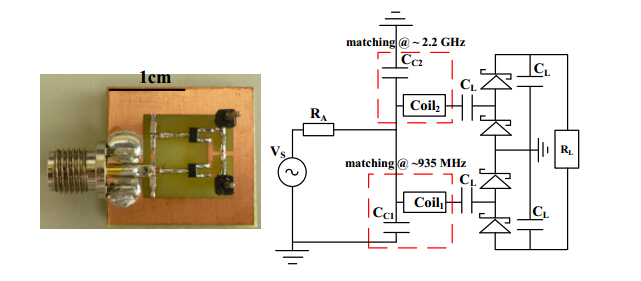 Figure 6. Picture and circuit layout of the dual-band RF harvester. The harvester is matched at 935MHz and 2.2GHz. Schottky diodes are HSMS-285x series. CC1=2.7pF, Coil1 =39nH; Coil1 QU @ 900MHz =88, CC2=0.8pF, Coil2 =2.14nH; Coil2 QU @ 1.7GHz =35, CL=100pF.
Figure 6. Picture and circuit layout of the dual-band RF harvester. The harvester is matched at 935MHz and 2.2GHz. Schottky diodes are HSMS-285x series. CC1=2.7pF, Coil1 =39nH; Coil1 QU @ 900MHz =88, CC2=0.8pF, Coil2 =2.14nH; Coil2 QU @ 1.7GHz =35, CL=100pF.

By replacing the diodes in Figure 6 with its linearized model (see Figure 5), its output DC characteristics can be analyzed with the same approach presented in Section 2.4.
The presented linearized model, ADS HB simulations and measured voltage sensitivity for the harvesters presented in Figure 4 and Figure 6 are shown in Figure 7. For the harvester presented in Figure 4, a DC voltage of 0.4V across RL of 0.5MΩ is measured at −20dBm input RF power. At −14dBm input RF power, the harvester as shown in Figure 4 delivers a measured DC voltage of 1V across a 0.5MΩ RL. The harvester achieves a peak efficiency of 24% and 41% at −20dBm and −10dBm input RF power respectively for about 6kΩRLwhen operating at 930MHz.
For the harvester shown in Figure 6, a DC voltage of 0.43V across a 0.5MΩ RL is measured at −20dBm input RF power at 935MHz. At −14.4dBm input RF power, the harvester as shown in Figure 6 delivers a measured DC voltage of 1V across a 0.5MΩ RL. At 5dBm input RF power, a DC voltage of 6V is measured across a 0.5MΩ RL at 935MHz. The harvester achieves a peak efficiency of 16% and 35% at −20dBm and −10dBm input RF power respectively for about 10kΩRL when operating at 935MHz. At 2.2GHz, an output DC voltage of 0.4V is measured across a 0.5MΩ RL at −10dBm input RF power. At 2.2GHz, a peak efficiency of 4% is measured at −10dBm input RF power for about 10kΩRL.
From the results shown in Figure 7, the maximum calculated deviation between measurements and the presented linearized model is 15%. The 15% maximum difference is as a result of calculating the diode RD and IDC. IDC is dependent on PA, Γ at Zin, RD and RL, as a result any variation such as component tolerances in these parameters affects the estimation of the output DC voltage. RD is also a function of the RL and PA.
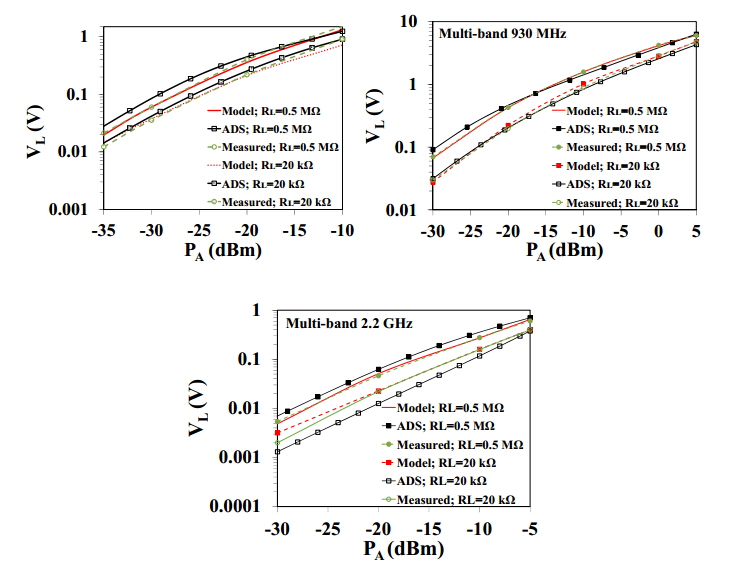 Figure 7. Presented linearized model as compared to Agilent ADS HB simulations and measurements. VL is the output DC voltage and PAis the input RF power. (Top-left) Results of the RF harvester as shown in Figure 4. (Top-right) Results of the dual-band RF harvester as shown in Figure 6 at 930MHz. (Bottom) Results of the dual-band RF harvester as shown in Figure 6 at ~2.2GHz.
Figure 7. Presented linearized model as compared to Agilent ADS HB simulations and measurements. VL is the output DC voltage and PAis the input RF power. (Top-left) Results of the RF harvester as shown in Figure 4. (Top-right) Results of the dual-band RF harvester as shown in Figure 6 at 930MHz. (Bottom) Results of the dual-band RF harvester as shown in Figure 6 at ~2.2GHz.
The maximum DC load power from the rectifier may be approximated by (17). Where PLmax is the maximum power delivered to the RL. The DC load resistance that results in the maximum efficiency from the RF harvester is given by (18). RLmax is the DC load resistance RL that results in the maximum η. For Figure 4, RLmax is ~6kΩ. For Figure 6, RLmax is ~10kΩ. From (8) and (17), the diode RD and peak voltage into a diode rectifier VD, must be high as possible for high voltage sensitivity of the RF harvester.

From the linearized transfer functions that describe the performance of an RF harvester, a maxima of PL (PLmax), RL (RLmax), η and γ may be found for any RF harvester topology.
The harvester shown in Figure 6 is realized to cover the LTE-800 MHz or GSM 900MHz and GSM 2110MHz frequency bands (see Figure 8). Hence the realized harvester loaded quality factor (∝@\sqrt {{R_D}/} {R_A}@) is low at 935MHz and 2100MHz.
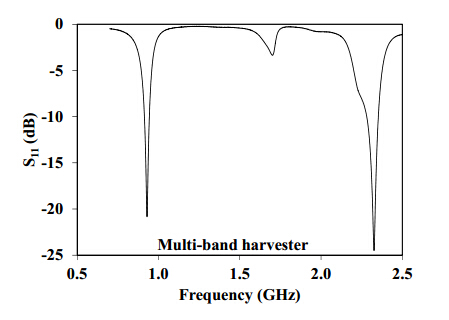 Figure 8. Measured open circuit S11 of the dual-band RF harvester. The input RF power level is −15dBm. The 3-dB return loss frequency bandwidth is 120MHz around 930MHz and 200MHz around 2.2GHz.
Figure 8. Measured open circuit S11 of the dual-band RF harvester. The input RF power level is −15dBm. The 3-dB return loss frequency bandwidth is 120MHz around 930MHz and 200MHz around 2.2GHz.
For RF harvesting applications which require such broad-band operations, diodes with low RD should be considered. Diodes with lower Cjand RSare always preferable in RF energy harvesting applications. RS consumes ohmic power, hence the lower the better. Cj in the range of 1pF reduces the diodes RD as well as its switching speed. The action of Cjdominates at sufficiently higher diode operating frequencies resulting in lower attainable RD. Since diodes are more sensitive to high voltage at input power levels less than −10dBm, a low RD results in limited voltage transformation. As a result more current goes through the diode and the diodes voltage losses Vj tend to be maximum. Hence at low diode input RD, the efficiency of rectifying RF signals is skewed towards the diodes with IS in the micro-amp range (such as HSMS-285x series), since they have lower peak Vj.
Impedance transformation components with high unloaded quality factor Quare always preferable in RF energy harvesting applications. The question always arise whether to use discrete components or transmission lines on a PCB. The unloaded quality factor of a transmission line may be described by (19)[15]. Where F0 is the transmission line frequency in mega-hetz, A0 is the attenuation in dB/100feet at F0 and VF is the velocity factor.

As an example, an inductive or capacitive transmission line on an FR4 PCB has VF of 0.48 and A0 of 132dB/100feet at 1GHz. Using (19) and the values of an FR4 transmission line at 1GHz gives aQuof 44. Hence up to 1GHz, discrete components may be preferred to transmission lines for impedance transformation since chip inductors and capacitors can provide Qu of up to 80 and 1000 at 1GHz respectively. However, sinceinductive transmission lines quality factor is directly proportional to the operating frequency, it may be preferred to discrete inductors at frequencies above 3GHz.
For RF harvesting applications with input power levels greater than −10dBm, diodes may be cascaded as in multipliers. This is due to the possible constant output voltage or power of a single rectifier stage after a certain threshold input RF power. The appropriate number of diode doubler stages that strikes a good balance between the losses Vj across the diodes in the multiplier and the power saturation of the rectifier stage must be made. Equation (20) may be used as a guide in choosing the number of rectifier voltage doubler stages N and the peak voltage or power handling capabilities of the rectifier.
| RFpower{VD<<Vj;N=1Vj<<VD<VBV;NVD≈VBV;N+1} | (20) |
The maximum DC voltage that can be outputted by a diode is determined by the reverse breakdown voltage VBV. The maximum output DC voltage VL of a single diode rectifier is ~VBV/2[2]. Hence the maximum output DC voltage of a diode voltage doubler is ~VBV and for a multiplier, it is ~NVBV.
At 868MHz, the commercially available Huber+Suhner SPA 860 (1308.17.0058) planar antenna [16] was used as a transmitter. The Huber+Suhner SPA 860 has a gain Gitof 8dBi at 868MHz and measures 20cm×20cm in size. The antenna presented by Homg-Dean Chen et al. [17] was used to receive the wireless signals at 868MHz. The antenna by Homg-Dean Chen et al. (see Figure 11) is a dual-band antenna with a 10-dB return loss bandwidth of 90MHz around 900MHz and 218MHz around 1800MHz. It has a gain Girof 1dBi at around 900MHz and 3dBiaround 1800MHz.
The size of the antenna is 6cm×8 cm, λ/4 at 868MHz. The dual-band rectifier as presented in Figure 6 is used with the antenna for harvesting at 868MHz. The transmitted RF power Ptwas 1W at 868MHz.The experimental setup and the wireless range measurements were performed in a warehouse as can be seen in Figure 9(Left). The sending and the receiving antennas were arranged ~1.5m above the ground. The rectenna delivered DC voltage was measured with the Keithley 6514 electrometer.
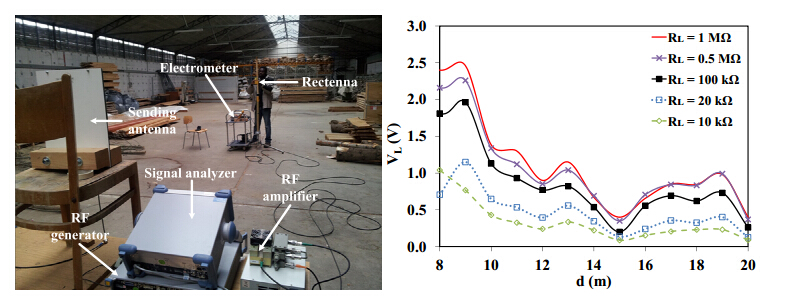 Figure 9. (Left) Picture of the experimental setup for the wireless range measurements at 868MHz. (Right) Rectenna (antenna + rectifier) receiving range performance by sending Ptof 1W at 868MHz. Transmitting antenna size is 20cm×20cm with Gitof 8dBi. Receiving rectenna size is 6cm×8cm. d is the distance between transmitter and rectenna.
Figure 9. (Left) Picture of the experimental setup for the wireless range measurements at 868MHz. (Right) Rectenna (antenna + rectifier) receiving range performance by sending Ptof 1W at 868MHz. Transmitting antenna size is 20cm×20cm with Gitof 8dBi. Receiving rectenna size is 6cm×8cm. d is the distance between transmitter and rectenna.
Figure 9(Right) shows the range measurements at 868MHz. A harvested DC voltage of 0.4V is measured across a 0.5MΩ RLat the distance of 20m. At 13m, 1VDC voltage is measured across a 0.5MΩ RL. The far-field results at 868MHz show that the received power generally degrades with 1/d2as in the Friis equation (21) [18]. Where Pr and Pt are the transmitted and received power respectively. λ is the wavelength of the RF signal. ξas in (21) is an additionalparameter in the Friis equation which account for reflections and multi-path propagations of the wireless signals. It can be seen from Figure 9(Right) that the measured output DC power is modulated by the constructive and destructive interferences along 1/d2, since there are farther distances where the delivered power is greater than a nearer range. This is evident at a distance dof 15m, where a DC output voltage of 0.5V is harvested as compared to 1V harvested atd of 19m for 0.5MΩ RL. At 15m there is destructive interferencefrom to the reflected signals to the direct signals, hence the harvested power is lower than that predicted by the original Friis formula, however, at 19m, there is constructive interference and the harvested power is higher than that predicted by the original Friis formula.

To investigate the possible use of ambient RF power sources for operation of remote micro-watt sensors. The RF power levels harvested by a ~λ/4 receiving antenna at 930MHz was first measured at a distance of about 110m from a GSM base station. The receiving antenna that was used for this experiment is the dual-band antenna by Homg-Dean Chen et al. [17].
Due to reflections, multi-path propagation and the fact that the transmitting antennas from the GSM base station point at different directions (see Figure 11), the power delivered by the dual-band receiving antenna was not estimated by the Friis formula [18] as in Equation 21. The power delivered by the receiving antenna were made by on-site measurements using a Rohde & Schwarz PR100 RF monitor. From the balcony of a building, about a distance of 110m from a GSM transceiver base station, the antenna was positioned to harvest the ambient RF power. Figure 10 shows the average (over 5 minutes) harvested RF power levels of the dual-band receiving antenna at a distance of about 110m from the GSM base station.
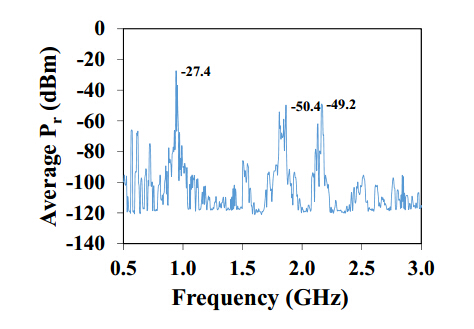 Figure 10. Average (over 5 minutes) ambient RF power delivered by the dual-band antenna at a distance of about 110m from a GSM base station. Receiving antenna size is 6cm×8cm (~λ/4 at 930MHz) with a gain of 1dBi at 930MHz and 3dBi at 1800MHz.
Figure 10. Average (over 5 minutes) ambient RF power delivered by the dual-band antenna at a distance of about 110m from a GSM base station. Receiving antenna size is 6cm×8cm (~λ/4 at 930MHz) with a gain of 1dBi at 930MHz and 3dBi at 1800MHz.
The GSM base station is located in the city of Freiburg, Germany at 48.0087, 7.829022 coordinates. Table 2shows the transmitting parameters of the GSM base station.
| Transmitter | 1 | 2 | 3 | 4 | 5 | 6 |
| Frequency (MHz) | 935 | 935 | 2160 | 2160 | 2160 | 811 |
| Transmitting power (W) | 102 | 102 | 32 | 32 | 32 | 30 |
| Number of channels | 1 | 1 | 2 | 2 | 2 | 2 |
| Antenna gain (dBi) | 15.7 | 15.7 | 18.0 | 18.0 | 18.0 | 15.8 |
Figure 10 shows that the harvested power levels by the dual-band receiving antenna, from the various frequency bands of a GSM base station ranges from −27dBm to −50dBm at a distance of about 110m. Figure 11 shows the output DC voltage from the dual-band rectifier and the dual-band [17] receiving antenna. Figure 11shows a harvested output DC voltage of about 2.3V across a ~0.5MΩ resistor is achieved from the several GSM power sources at a distance of 110m.
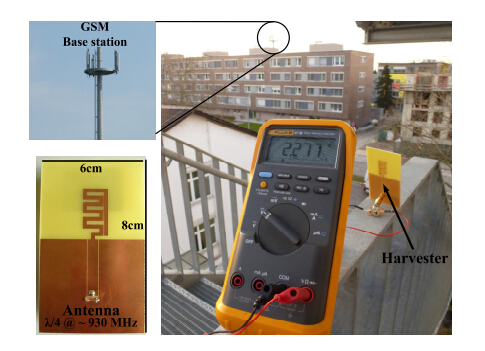 Figure 11. Setup for measuring the power delivered by the GSM base station across a resistive load. The RF to DC rectifier is the circuit as presented in Figure 6 and the antenna is from Homg-Dean Chen et al. [17]. RL is ~0.5MΩ. VL is about 2.3V.
Figure 11. Setup for measuring the power delivered by the GSM base station across a resistive load. The RF to DC rectifier is the circuit as presented in Figure 6 and the antenna is from Homg-Dean Chen et al. [17]. RL is ~0.5MΩ. VL is about 2.3V.
The delivered DC power by the rectenna is the sum of all the harvested RF signals in the multiple transmitting frequencies (811 MHz, 935MHz and 2160MHz) of the base station. The harvested DC power can be approximate by (22) [8]. Where C1 up to CN are the transmitting channels. For GSM signals, a channel covers 200kHz. f1 and f2 are the lower and upper band of the RF frequency respectively. f is the frequency. Using this approach, ambient RF power sources in the range of −27dBm to −50dBmand from different frequencies can be utilized to power sensors requiring ~1.3V DC across a 0.5MΩ and still maintain a ~λ/4 rectenna size.

The RF harvester was also loaded with a commercially available TFA 30.5014.02 Thermo-Hygrometer. The Thermo-Hygrometer is normally powered by an LR44 battery requiring 1.3V to 1.5V at 3µ Afor its continuous operation. It can be seen that the RF harvester was also able to power the sensor through startup-mode and steady state operations (see Figure 12). Since the Thermo-Hygrometer has an input resistance of ~0.5MΩ and consumes ~1.3V, the theoretical distance at which the Thermo-Hygrometer may still be powered by the presented RF harvester is about 220m using the GSM base station.
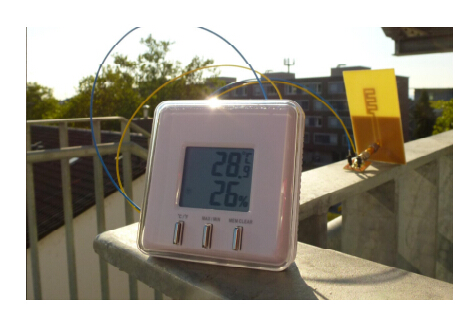 Figure 12. Using ambient RF GSM power to operate Thermo-Hygrometer sensor. The RF to DC rectifier is as presented in Figure 6.
Figure 12. Using ambient RF GSM power to operate Thermo-Hygrometer sensor. The RF to DC rectifier is as presented in Figure 6.
By using a linearized model of a rectifier, a complete description of an RF harvester can be made without compromise. This analysis is confirmed by measured results and HB computer aided simulations for different RF harvester circuit topologies. It is shown that an RF harvester can be optimized using the equations from a linearized RF harvester model. This provides a unique advantage over computer aided simulations which gives little insight into the design trade-off and the effect of the component parameters on the performance of the harvester. The theory presented in this paper could be used for broad design considerations before a specific RF harvester circuit topology is adapted. The theory has been proved by using low cost off-the-shelf components. However the model is equally applicable to custom made designs based on complementary metal-oxide-semiconductor (CMOS) process. It has been shown that using a dual-band RF harvester, ambient RF power sources in the range of −27dBm to −50dBm from different frequency bands can be used to provide perpetual energy for operation of wireless remote sensors requiring 1.3V at 0.5MΩ. This has been achieved by using rectenna size of ~λ/4 at 930MHz. In the ISM 868MHz frequency band, an operation range of 19m is demonstrated for DC loads requiring 1V at 0.5MΩ from a single transmitted signal at indoor conditions.
This work is part of the graduate program GRK 1322 Micro Energy Harvesting at IMTEK, University of Freiburg, funded by the German Research Foundation (DFG).
There is no conflict of interest.
| [1] |
Shen JJ, Gonçalves R, Choi YT, et al. (2023) Microstructure and mechanical properties of gas metal arc welded CoCrFeMnNi joints using a 308 stainless steel filler metal. Scripta Mater 222: 115053. https://doi.org/10.1016/j.scriptamat.2022.115053 doi: 10.1016/j.scriptamat.2022.115053

|
| [2] |
Shen JJ, Agrawal P, Rodrigues TA, et al. (2022) Gas tungsten arc welding of as-cast AlCoCrFeNi2.1 eutectic high entropy alloy. Mater Design 223: 111176. https://doi.org/10.1016/j.matdes.2022.111176 doi: 10.1016/j.matdes.2022.111176

|
| [3] |
Li BQ, Wang L, Wang BB, et al. (2022) Electron beam freeform fabrication of NiTi shape memory alloys: Crystallography, martensitic transformation, and functional response. Mater Sci Eng A 2022: 143135. https://doi.org/10.1016/j.msea.2022.143135 doi: 10.1016/j.msea.2022.143135

|
| [4] |
Felice IO, Shen JJ, Barragan A, et al. (2023) Wire and arc additive manufacturing of Fe-based shape memory alloys: Microstructure, mechanical and functional behavior. Mater Design 231: 112004. https://doi.org/10.1016/j.matdes.2023.112004 doi: 10.1016/j.matdes.2023.112004

|
| [5] |
Yusuf SM, Cutler S, Gao N (2019) Review: The impact of metal additive manufacturing on the aerospace industry. Metal 9: 1286. https://doi.org/10.3390/met9121286 doi: 10.3390/met9121286

|
| [6] |
Makhutov NA, Matvienko YG, Blednova ZM, et al. (2022) The effect of surface coating by shape memory alloys on mechanical properties of steel. Fatigue Fract Eng M 45: 1550–1553. https://doi.org/10.1111/ffe.13672 doi: 10.1111/ffe.13672

|
| [7] |
Tang H, Tao W, Wang H, et al. (2018) High-performance infrared emissivity of micro-arc oxidation coatings formed on titanium alloy for aerospace applications. Int J Appl Ceram Tec 15: 579–591. https://doi.org/10.1111/ijac.12861 doi: 10.1111/ijac.12861

|
| [8] |
Bhutta MU, Khan ZA (2020) Wear and friction performance evaluation of nickel based nanocomposite coatings under refrigerant lubrication. Tribol Int 148: 106312. https://doi.org/10.1016/j.triboint.2020.106312 doi: 10.1016/j.triboint.2020.106312

|
| [9] |
Segura-Cardenas E, Ramirez-Cedillo EG, Sandoval-Robles JA, et al. (2017) Permeability study of austenitic stainless steel surfaces produced by selective laser melting. Metals 7: 521. https://doi.org/10.3390/met7120521 doi: 10.3390/met7120521

|
| [10] |
Haro EE, Odeshi AG, Szpunar JA (2016) The energy absorption behavior of hybrid composite laminates containing nano-fillers under ballistic impact. Int J Impact Eng 96: 11–22. https://doi.org/10.1016/j.ijimpeng.2016.05.012 doi: 10.1016/j.ijimpeng.2016.05.012

|
| [11] |
Mishnaevsky LJR (2019) Toolbox for optimizing anti‐erosion protective coatings of wind turbine blades: Overview of mechanisms and technical solutions. Wind Energy 22: 1636–1653. https://doi.org/10.1002/we.2378 doi: 10.1002/we.2378

|
| [12] | Ahmadnia A (2000) Energy Absorption of Macrocomposite Laminates, London: Queen Mary University of London. http://qmro.qmul.ac.uk/xmlui/handle/123456789/1342 |
| [13] |
Wadsworth J, Lesuer DR (2000) Ancient and modern laminated composites—from the great pyramid of gizeh to Y2K. Mater Charact 45: 289–313. https://doi.org/10.1016/S1044-5803(00)00077-2 doi: 10.1016/S1044-5803(00)00077-2

|
| [14] |
Sun MY, Bai YH, Li MX, et al. (2018) Structural design and energy absorption mechanism of laminated SiC/BN ceramics. J Eur Ceram Soc 38: 3742–3751. https://doi.org/10.1016/j.jeurceramsoc.2018.04.052 doi: 10.1016/j.jeurceramsoc.2018.04.052

|
| [15] |
Naidoo LC, Fatoba O, Akinlabi S, et al. (2020) Material characterization and corrosion behavior of hybrid coating Ti-Al-Si-Cu/Ti-6Al-4V composite. Materialwiss Werkstofftech 51: 766–773. https://doi.org/10.1002/mawe.202000019 doi: 10.1002/mawe.202000019

|
| [16] |
Rusinov PO, Blednova ZM, Kurapov GV (2023) Functionally oriented composite layered materials with martensitic transformations. Surf Innov 11: 26–37. https://doi.org/10.1680/jsuin.21.00077 doi: 10.1680/jsuin.21.00077

|
| [17] |
Anand EE, Natarajan S (2015) Effect of carbon nanotubes on corrosion and tribological properties of pulse-electrodeposited Co-W composite coatings. J Mater Eng Perform 24: 128–135. https://doi.org/10.1007/s11665-014-1306-z doi: 10.1007/s11665-014-1306-z

|
| [18] |
Rusinov PO, Blednova ZM, Rusinova AA, et al. (2023) Development and Research of New Hybrid Composites in Order to Increase Reliability and Durability of Structural Elements. Metals 13: 1177. https://doi.org/10.3390/met13071177 doi: 10.3390/met13071177

|
| [19] |
Xiong JJ, Zhu YT, Luo CY, et al. (2021) Fatigue-driven failure criterion for progressive damage modelling and fatigue life prediction of composite structures. Int J Fatigue 145: 106110. https://doi.org/10.1016/j.ijfatigue.2020.106110 doi: 10.1016/j.ijfatigue.2020.106110

|
| [20] |
Kong WW, Yuan C, Zhang BN (2020) Investigations on cyclic deformation behaviors and corresponding failure modes of a Ni-Based superalloy. Mater Sci Eng A 791: 139775. https://doi.org/10.1016/j.msea.2020.139775 doi: 10.1016/j.msea.2020.139775

|
| [21] |
Cho H, Nam S, Hwang I, et al. (2019) Fatigue behaviors of resistance spot welds for 980 MPa grade TRIP steel. Metals 9: 1086. https://doi.org/10.3390/met9101086 doi: 10.3390/met9101086

|
| [22] |
Su ZM, Lin PC, Lai WJ, et al. (2020) Fatigue analyses and life predictions of laser-welded lap-shear specimens made of low carbon and high strength low alloy steels. Int J Fatigue 140: 105849. https://doi.org/10.1016/j.ijfatigue.2020.105849 doi: 10.1016/j.ijfatigue.2020.105849

|
| [23] |
Watanabe H, Murata T, Nakamura S, et al. (2021) Effect of cold-working on phase formation during heat treatment in CrMnFeCoNi system high-entropy alloys with Al addition. J Alloys Compd 872: 159668. https://doi.org/10.1016/j.jallcom.2021.159668 doi: 10.1016/j.jallcom.2021.159668

|
| [24] |
Wang M, Huang MX (2020) Abnormal TRIP effect on the work hardening behavior of a quenching and partitioning steel at high strain rate. Acta Mater 188: 551–559. https://doi.org/10.1016/j.actamat.2020.02.035 doi: 10.1016/j.actamat.2020.02.035

|
| [25] |
Behravan A, Zarei-Hanzaki A, Fatemi SM, et al. (2019) The effect of aging temperature on microstructure and tensile properties of a novel designed Fe-12Mn-3Ni Maraging-TRIP steel. Steel Research Int 90: 1800282. https://doi.org/10.1002/srin.201800282 doi: 10.1002/srin.201800282

|
| [26] |
Tan XD, He HS, Lu WJ, et al. (2020) Effect of matrix structures on TRIP effect and mechanical properties of low-C low-Si Al-added hot-rolled TRIP steels. Mater Sci Eng A 771: 138629. https://doi.org/10.1016/j.msea.2019.138629 doi: 10.1016/j.msea.2019.138629

|
| [27] |
Yang J, Jo YH, Kim DW, et al. (2020) Effects of transformation-induced plasticity (TRIP) on tensile property improvement of Fe45Co30Cr10V10Ni5-xMnx high-entropy alloys. Mater Sci Eng A 772: 138809. https://doi.org/10.1016/j.msea.2019.138809 doi: 10.1016/j.msea.2019.138809

|
| [28] | Isakaev EK, Mordynsky VB, Sidorova EV, et al. (2011) Comparative analysis of methods for measuring the porosity of gas-thermal coatings. Eng technol 3: 25–30. http://www.ltc.ru/newsltc/2/1009_1.shtml |
| [29] |
Kustas AB, Jones MR, DelRio FW, et al. (2022) Extreme hardness at high temperature with a lightweight additively manufactured multi-principal element superalloy. Appl Mater Today 29: 101669. https://doi.org/10.1016/j.apmt.2022.101669 doi: 10.1016/j.apmt.2022.101669

|
| [30] |
Whitfield TE, Stone HJ, Jones CN, et al. (2021) Microstructural degradation of the AlMo0.5NbTa0.5TiZr refractory metal high-entropy superalloy at elevated temperatures. Entropy 23: 80. https://doi.org/10.3390/e23010080 doi: 10.3390/e23010080

|
| [31] |
Rusinov PO, Blednova, ZM (2022) Study of the structure and properties of a high-entropy ceramic composite material. Surf Innov 10: 217–226. https://doi.org/10.1680/jsuin.21.00047 doi: 10.1680/jsuin.21.00047

|
| [32] |
Zhao YC, Zhao PB, Li WS, et al. (2019) The microalloying effect of Ce on the mechanical properties of medium entropy bulk metallic glass composites. Crystals 9: 483. https://doi.org/10.3390/cryst9090483 doi: 10.3390/cryst9090483

|
| 1. | Ping Lu, Xue-Song Yang, Bing-Zhong Wang, A Two-Channel Frequency Reconfigurable Rectenna for Microwave Power Transmission and Data Communication, 2017, 65, 0018-926X, 6976, 10.1109/TAP.2017.2766450 | |
| 2. | Kazuya Tada, Comment on “Simulation of current–voltage curves for inverted planar structure perovskite solar cells using equivalent circuit model with inductance”, 2017, 10, 1882-0778, 059101, 10.7567/APEX.10.059101 | |
| 3. | P. V. Bulat, A. A. Ukhov, I. A. Volobuev, S. V. Shapovalov, R. V. Li, Wireless Data Collecting Device with RF Energy Harvester for Aircraft, 2020, 63, 1068-7998, 508, 10.3103/S1068799820030186 | |
| 4. | Sandhya Chandravanshi, M.J. Akhtar, Design of efficient rectifier using IDC and harmonic rejection filter in GSM/CDMA band for RF energy harvesting, 2017, 59, 08952477, 681, 10.1002/mop.30365 | |
| 5. | Saikat Paul, Aakash Ravichandran, Mukul Varshney, Sujata Pandey, 2019, Chapter 18, 978-981-10-8967-1, 209, 10.1007/978-981-10-8968-8_18 | |
| 6. | Sandhya Chandravanshi, M. Jaleel Akhtar, 2017, Design of efficient rectifying circuit for RF energy harvesting applications, 978-1-5386-2393-0, 1, 10.1109/AEMC.2017.8325694 | |
| 7. | Sviatoslav Iakimenko, Daria Ikonnikova, 2020, Chapter 10, 978-3-030-65725-3, 110, 10.1007/978-3-030-65726-0_10 | |
| 8. | Ludmila Cojocaru, Satoshi Uchida, Piyankarage V. V. Jayaweera, Shoji Kaneko, Yasutake Toyoshima, Jotaro Nakazaki, Takaya Kubo, Hiroshi Segawa, Simulation of current–voltage curves for inverted planar structure perovskite solar cells using equivalent circuit model with inductance, 2017, 10, 1882-0778, 025701, 10.7567/APEX.10.025701 | |
| 9. | Daasari Surender, Taimoor Khan, Fazal A. Talukdar, Asok De, Yahia M.M. Antar, Al. P. Freundorfer, Key Components of Rectenna System: A Comprehensive Survey, 2020, 0377-2063, 1, 10.1080/03772063.2020.1761268 | |
| 10. | Mustafa Cansiz, Dogay Altinel, Gunes Karabulut Kurt, Efficiency in RF energy harvesting systems: A comprehensive review, 2019, 174, 03605442, 292, 10.1016/j.energy.2019.02.100 | |
| 11. | Andry Contreras, Maryory Urdaneta, Rectenas para el Cosechamiento de Energía de los Sistemas de Comunicaciones en RF: Una Revisión, 2020, 43, 02540770, 98, 10.22209/rt.v43n2a06 | |
| 12. | Ludmila Cojocaru, Satoshi Uchida, Piyankarage V. V. Jayaweera, Shoji Kaneko, Yasutake Toyoshima, Jotaro Nakazaki, Takaya Kubo, Hiroshi Segawa, Reply to “Comment on ‘Simulation of current–voltage curves for inverted structure perovskite solar cells using equivalent circuit model with inductance’ ”, 2017, 10, 1882-0778, 059102, 10.7567/APEX.10.059102 | |
| 13. | Usman Raza, Abdul Salam, On-Site and External Energy Harvesting in Underground Wireless, 2020, 9, 2079-9292, 681, 10.3390/electronics9040681 | |
| 14. | Naveed Anwar Bhatti, Muhammad Hamad Alizai, Affan A. Syed, Luca Mottola, Energy Harvesting and Wireless Transfer in Sensor Network Applications, 2016, 12, 1550-4859, 1, 10.1145/2915918 | |
| 15. | Pankaj Agrawal, Akhilesh Tiwari, Uday Pratap Singh, 2018, chapter 15, 9781522535317, 311, 10.4018/978-1-5225-3531-7.ch015 | |
| 16. | Rachit Dana, Parthit Sardhara, Akshay Sanghani, Prarthan Mehta, 2020, Chapter 6, 978-981-13-6158-6, 43, 10.1007/978-981-13-6159-3_6 | |
| 17. | Matt H. Straughn, , 2016, Efficient RF energy harvesting circuitry study, 978-8-8907-0186-3, 1, 10.1109/EuCAP.2016.7481819 | |
| 18. | Extending Wireless Rechargeable Sensor Network Life without Full Knowledge, 2017, 17, 1424-8220, 1642, 10.3390/s17071642 | |
| 19. | Rajdevinder Kaur Sidhu, Jagpal Singh Ubhi, Alpana Aggarwal, 2019, A Survey Study of Different RF Energy Sources for RF Energy Harvesting, 978-1-5386-8010-0, 530, 10.1109/ICACTM.2019.8776726 | |
| 20. | 2020, 9781119390022, 301, 10.1002/9781119390060.ch12 | |
| 21. | Esraa Mousa Ali, Nor Zaihar Yahaya, Omar Aqeel Saraereh, Anwar Hamdan Al Assaf, Bilal Hasan Alqasem, Shahid Iqbal, Oladimeji Ibrahim, Amit V Patel, Power Conversion Using Analytical Model of Cockcroft–Walton Voltage Multiplier Rectenna, 2021, 10, 2079-9292, 881, 10.3390/electronics10080881 | |
| 22. | Federico Villani, Philipp Mayer, Michele Magno, 2021, RF Power Transmission, 9781450390972, 592, 10.1145/3485730.3493365 | |
| 23. | Sergejs Tjukovs, Janis Eidaks, Dmitrijs Pikulins, 2018, Experimental Verification of Wireless Power Transfer Ability to Sustain the Operation of LoRaWAN Based Wireless Sensor Node, 978-1-5386-5558-0, 83, 10.1109/RTUWO.2018.8587790 | |
| 24. | Humberto P. Paz, Vinicius S. Silva, Eduardo V.V. Cambero, Humberto X. Araújo, Ivan R.S. Casella, Carlos E. Capovilla, A survey on low power RF rectifiers efficiency for low cost energy harvesting applications, 2019, 112, 14348411, 152963, 10.1016/j.aeue.2019.152963 | |
| 25. | Surajo Muhammad, Jun Jiat Tiang, Sew Kin Wong, Ali H. Rambe, Ismahayati Adam, Amor Smida, Mohamed Ibrahim Waly, Amjad Iqbal, Adamu Saidu Abubakar, Mohd Najib Mohd Yasin, Harvesting Systems for RF Energy: Trends, Challenges, Techniques, and Tradeoffs, 2022, 11, 2079-9292, 959, 10.3390/electronics11060959 | |
| 26. | Chemseddine Benkalfate, Achour Ouslimani, Abed-Elhak Kasbari, Mohammed Feham, A New RF Energy Harvesting System Based on Two Architectures to Enhance the DC Output Voltage for WSN Feeding, 2022, 22, 1424-8220, 3576, 10.3390/s22093576 | |
| 27. | Efe Francis Orumwense, Khaled Abo-Al-Ez, On Increasing the Energy Efficiency of Wireless Rechargeable Sensor Networks for Cyber-Physical Systems, 2022, 15, 1996-1073, 1204, 10.3390/en15031204 | |
| 28. | Kamini Singh, Sanjeev Yadav, J.K. Deegwal, M.M. Sharma, 2022, 9781119791805, 85, 10.1002/9781119792581.ch5 | |
| 29. | Songfan Li, Li Lu, Muhammad Jawad Hussain, Yalan Ye, Hongzi Zhu, Sentinel: Breaking the Bottleneck of Energy Utilization Efficiency in RF-Powered Devices, 2019, 6, 2327-4662, 705, 10.1109/JIOT.2018.2854374 | |
| 30. | Geetha Palani, A. Arputhalatha, Karthik Kannan, Poobana Dharmalingam, S. Esther Gandhimathi, 2023, 9780323951081, 127, 10.1016/B978-0-323-95108-1.00007-0 | |
| 31. | Efe F Orumwense, Khaled Abo-Al-Ez, 2021, A Charging Technique for Sensor Nodes in Wireless Rechargeable Sensor Networks for Cyber-physical Systems, 978-1-6654-4231-2, 1, 10.1109/ICECET52533.2021.9698607 | |
| 32. | Ioannis D. Bougas, Maria S. Papadopoulou, Konstantinos Psannis, Panagiotis Sarigiannidis, Sotirios. K. Goudos, 2020, State-of-the-Art Technologies in RF Energy Harvesting Circuits – A Review, 978-1-7281-8564-4, 18, 10.1109/WSCE51339.2020.9275507 | |
| 33. | Abdullah Alghamdi, Ali M. Al Shahrani, Sultan Sughair AlYami, Ihtiram Raza Khan, P. S. G. Aruna Sri, Papiya Dutta, Ali Rizwan, Prashanth Venkatareddy, Security and energy efficient cyber-physical systems using predictive modeling approaches in wireless sensor network, 2023, 1022-0038, 10.1007/s11276-023-03345-1 | |
| 34. | Eduardo V. Valdés Cambero, Vinícius S. Silva, Humberto P. Paz, Renan Trevisoli, Carlos E. Capovilla, Ivan R. S. Casella, 2024, Chapter 1, 978-3-031-37908-6, 3, 10.1007/978-3-031-37909-3_1 | |
| 35. | Pangsui Usifu Linge, Anvesh Pandey, Tony Gerges, Jean-Marc Duchamp, Philippe Benech, Jacques Verdier, Philippe Lombard, Fabien Mieyeville, Michel Cabrera, Pierre Tsafack, Bruno Allard, Evaluation of Recycled Cardboard Paper as an Eco-Friendly Substrate for Rectenna and Ambient Radio Frequency Energy Harvesting Application, 2024, 13, 2079-9292, 2499, 10.3390/electronics13132499 | |
| 36. | Ioannis D. Bougas, Maria S. Papadopoulou, Achilles D. Boursianis, Konstantinos Kokkinidis, Sotirios K. Goudos, State-of-the-Art Techniques in RF Energy Harvesting Circuits, 2021, 2, 2673-4001, 369, 10.3390/telecom2040022 | |
| 37. | Ioannis D. Bougas, Maria S. Papadopoulou, Achilles D. Boursianis, Panagiotis Sarigiannidis, Spyridon Nikolaidis, Sotirios K. Goudos, 2024, Energy Harvesting & Autonomous Energy Systems: A Proposal for RF Energy Harvesting, 979-8-3503-8542-7, 1, 10.1109/MOCAST61810.2024.10615601 | |
| 38. | Ramy Agieb, Ayman Amer, Ibrahim Mansour, Ahmed Solyman, Khalid Yahya, Ahmed Samir, Improving Energy Harvesting System from Ambient RF Sources in Social Systems with Overcrowding, 2025, 9, 2398-7294, 13, 10.26599/IJCS.2023.9100022 |
| IS(nA) | I(nA) | Cj(pF) | RS(Ω) | LS(nH) | CP(pF) | VBV(V) |
| 50 | 2 | 0.18 | 6 | 2 | 0.08 | 7 |
| Transmitter | 1 | 2 | 3 | 4 | 5 | 6 |
| Frequency (MHz) | 935 | 935 | 2160 | 2160 | 2160 | 811 |
| Transmitting power (W) | 102 | 102 | 32 | 32 | 32 | 30 |
| Number of channels | 1 | 1 | 2 | 2 | 2 | 2 |
| Antenna gain (dBi) | 15.7 | 15.7 | 18.0 | 18.0 | 18.0 | 15.8 |